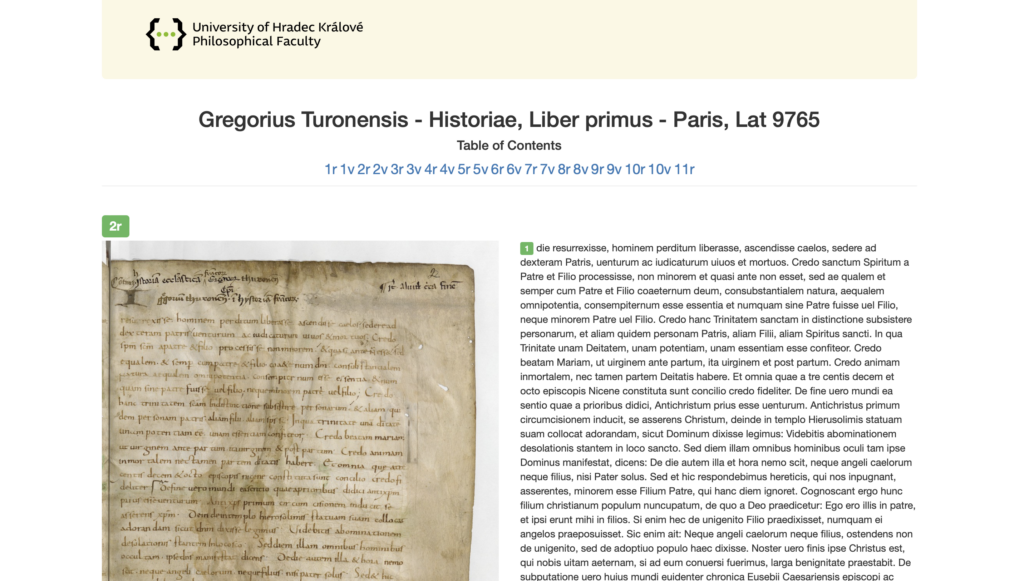Abstract
TEI-Parsel 1.0 is a Python application that transforms the content of XML-TEI document that follows Lombard Press Schema 1.0.0 guidelines (https://lombardpress.org/schema/docs/diplomatic/) into a web presentation. The web presentation is a static display of pages of the TEI document. Each page contains an image and a transcribed content. The application functions as a tool catering to the needs of historians, archivists, and philologists, facilitating the straightforward visualization of digital editions.
Technical Solution
Transcription of text encoded in XML-TEI
⬇
Conversion of XML-TEI in Python
⬇
Visualization on the internet
Example of Visualization

Contribution
- Enhanced Accessibility: TEI-Parsel 1.0 simplifies access with its user-friendly solution, granting researchers and the public easy access to historical documents.
- Efficient Research: Historians and scholars can analyze digitized documents without the need for specialized software, thus streamlining their research process.
- Preservation of Cultural Heritage: By transforming XML-TEI documents into web presentations, TEI-Parsel 1.0 contributes to the preservation and dissemination of cultural heritage.
- Collaborative Scholarship: TEI-Parsel 1.0 fosters collaboration among scholars by facilitating effortless sharing and discussion of digitized materials.
- Standardization and Interoperability: By adhering to Lombard Press Schema guidelines, TEI-Parsel 1.0 advocates for standardization and compatibility within the Digital Humanities community.
Manual
How to Use?
- Install python (miniconda) – Download from https://docs.conda.io/en/latest/miniconda.html
- Setup a specific python environment or use base one
- Clone the repository (or download it), cd to it
- Install dependencies
- Run the program from CLI
- Copy the generated file(html) + images + bootstrap folders to a location
Detailed Guide
Download and install miniconda (https://docs.conda.io/en/latest/miniconda.html)
Run Anaconda Prompt (miniconda3) – search with windows
cd c:\tei-parser (or to a location where you downloaded this repository)
Python environment setup (Required for running the program)
pip install -r requirements.txt
Python environment setup (Required for running the program)
Run from CLI (from root folder)
python run.py --input_file_path ./_example/Paris-Lat-9765.xml --output_file_path output-full.html
Example Structure of XML-TEI document

Extracted Fields
| Area | Tag | Desc | Example | Visualization |
| teiHeader | title | title | header, title | |
| author | author | header | ||
| editor | editor | footer | ||
| editionStmt/edition/date | data of translation | header | ||
| publicationStmt/authority/ref | authority | footer | ||
| publicationStmt/availability | license | footer | ||
| listWit/witness | witness | header | ||
| encodingDesc/editorialDecl | declaration | footer | ||
| text | pb | page break | <pb facs=““ n=“2v“/> | will break page; facs – link to an image; n – above page |
| p | paragraph | <p></p> | same as html p | |
| lb | line break | </lb> | not used | |
| note | note | <note></note> | under text, types do not matter, number the notes, display the number in the text | |
| quote | quote | <quote></quote> | italica (nothing else) | |
| ref | reference | <ref><name>Horosii</name> narrat<title>historia</title><link>seznam.cz</link></ref> | link <a href=“seznam.cz“><u>Horosiii narrat historia</u></a> |
The development of the TEI-Parsel 1.0 application was supported by an internal grant project conducted at Philosophical Faculty of the University of Hradec Králové „International Presentation of Codicological Research at the Philosophical Faculty, University of Hradec Králové II“. The application was created in collaboration with Jan Marek.
Realization: 2023
Authors: Michaela Falátková and Martin Dekarli, Department of Auxiliary Sciences of History and Archival Studies, Philosophical Faculty, University of Hradec Králové
